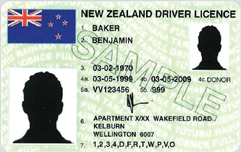
Luckily for us, driving in New Zealand is not much different to driving in South Africa. In this article we will take a look at how to convert your South African driver’s licenses to their Kiwi equivalents and what the differences are between driving in the two countries.
How to convert your SA drivers license into a Kiwi drivers license.
It couldn’t be any easier to be honest. When you arrive you are allowed to drive on your South African license for up to 12 months.
Driving Tip
We recommend that you do this for a while before converting your license. That way if you do get a fine while getting used to the difference in the speed limit, you will not get any demerit points on your New Zealand license.
When you are ready to convert your license, simply walk into any branch of the AA or VINZ (Vehicle Inspection New Zealand). You will need to take with you:
1) Your passport
2) Proof of Address like a utility bill
3) Your South African driver’s license
Make copies of each of these to take with as well.
You will then fill in an application form. They will then take a photo of you for your license as well as do a quick eye test. You will then pay around $50 to process the application.
You will then be issued a slip which confirms that you have applied for your New Zealand drivers license. If you are asked for your drivers license while you are waiting for the proper one to arrive, you will then need to produce this temporary license, so keep it with you at all times.
Your actual New Zealand drivers license will then arrive in the post a week or so later and will look like this:
Always carry your licence with you
You will always carry your drivers license on you as it is not only used to prove you have a valid drivers license, but it is also used to prove your identity when required, eg., at the bank or when opening an account at a store.
The difference between driving in New Zealand and South Africa
There are surprisingly few differences between driving in the two countries, so you will feel pretty much at home on the roads. There are however a few signs and road markings that are new which you will need to learn.
Left Turn Rule
Please note that the bizarre left turn right of way rule that used to be law in New Zealand does not apply anymore. You will use all the same turning rules that you used to use in South Africa. In other words if you are turning left, then the car on the opposite side of the road will need to wait for you as you have right of way.
The first and most significant difference is the speed limit. In built up areas it will generally be 50km/h and on the motorway it is 100km/h. The speed limit is calculated according to a formula, so pay careful attention to the signs as it can vary in built up areas between 50km/h and 70km/h.
On rural roads the limit will also vary, usually between 80km/h and 100km/h. Here you need to learn your first new sign – the De-restriction sign :

This sign tells you that you can now drive 100km/h again.
Also on rural roads you will often notice this sign :

It tells you that there is a single lane bridge ahead. The two arrows tell you which traffic has the right of way. The larger thicker arrow has the right of way. In the example above the oncoming traffic has right of way, so if there are oncoming traffic, you will need to stop behind the line in front of the bridge until that traffic has passed.
In built up areas you will often see this sign :

You will usually find the sign at traffic lights. It is pretty self explanatory, but I am pointing it out because sometimes the sign only says “Peds” instead of “Pedestrians”. So now you know what a Ped is.
When entering a busy motorway, you will often see a traffic light near the end of the on ramp. There will also be a sign like this below the traffic light :
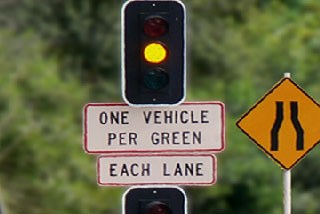
This traffic light will cycle quickly between green, red and yellow. The idea with these traffic lights is to reduce the amount of congestion on the motorway during peak traffic. You treat it as though it is a regular traffic light and will notice that it will generally let one car pass through at a time before changing.
Certain lanes are bus lanes only. These are often marked using a difference colour tar (usually red) as well as this sign overhead :
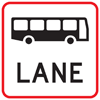
There are however times when these lanes can be used by regular traffic as well. If this is the case, then you will see a time sign along with the bus lane sign :
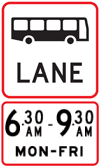
In certain areas you are not allowed to stop. These areas are marked like this :
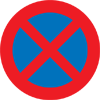
There may also be times when you can stop in these areas. The times when you may not stop there will be marked on the sign :

Around schools, the speed limit is 40km/h. The start of the school zone is marked as follows :

the end of the 40km/h zone is marked like this :

Pedestrian crossings are very clearly marked with sign posts that look like this :
![]()
as well as having the standard zebra markings on the road.
If there are pedestrians approaching or standing at the crossing you MUST stop.
WARNING
You cannot just ride and they will wait for you like in South Africa. Folks here are so used to the cars stopping for them that they sometimes just walk without even looking if there are cars coming. This is especially true of school children, so please be very careful around pedestrian crossings when you first arrive.




